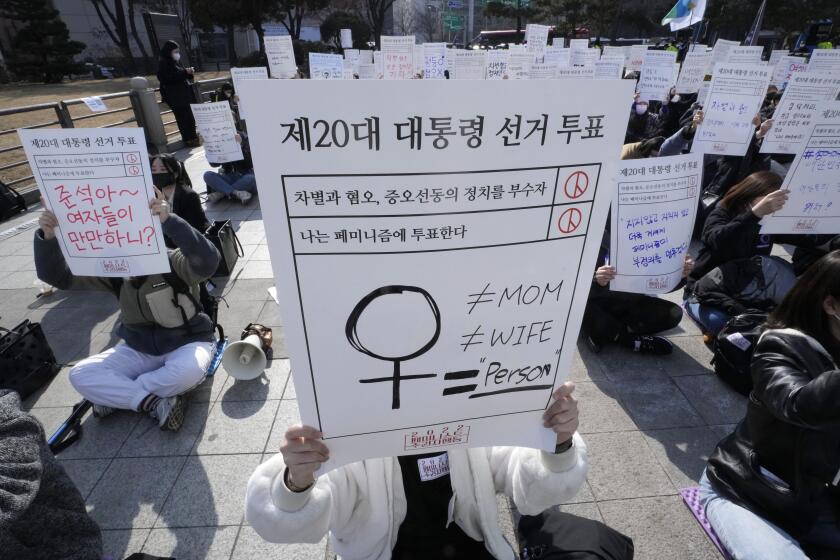Wartime Internment Camp Binds German POWs, American Guards
- Share via
STARK, N.H. — Fifty years ago in the northern White Mountains, the village of Stark became the unlikely site for a remarkable community: a World War II prisoner-of-war camp.
Camp Stark existed between April, 1944, and July, 1946, nearly doubling the community’s population of about 400. But despite wartime animosities and suspicions, it left a positive mark on residents of two continents.
In 1986, five former POWs and about 30 of the Americans who guarded them met for a German-American Friendship Day, a reunion 40 years after the lives of captive and captor, native and foreigner had touched.
About 1,000 people turned out for the reunion at Stark’s covered bridge and the festivities that followed, one of the most important days in Stark’s 220-year history.
Dartmouth College history professor Allan Koop, who chronicled Camp Stark in his book, “Stark Decency, German Prisoners of War in a New England Village,” describes the POW camp as “an island of decency in a world at war.”
Koop, the son of former Surgeon General C. Everett Koop, and Madeleine Croteau of the Stark Improvement Society organized the reunion. Now they’re looking to a 1996 observance, the 50th anniversary of the closing of Camp Stark and the 10th anniversary of the first reunion.
Camp Stark was home to about 300 of the nearly 400,000 Germans held prisoner in camps across the country. According to Koop, the camp came into existence because of New Hampshire’s powerful politicians.
Brown Paper Co., the North Country’s largest employer in nearby Berlin, desperately needed woodcutters for its pulp and paper mills because the war had depleted its work force.
Sherman Adams, a timberland manager in the North Country who was about to become a member of Congress and, later, governor and then aide to President Dwight D. Eisenhower, and U.S. Sen. Styles Bridges used their influence to get a POW camp to provide labor for Brown.
An abandoned Civilian Conservation Corps camp on the south side of Route 110 about 30 miles from the Canadian border became the camp. The 50 American guards lived in similar quarters on the north side of the road.
Five of the POWs later became American or Canadian citizens.
Except for a couple of chimney bases and guard-tower foundations, the camp now is but a clearing in the woods, only a roadside sign marking the site.
What made the camp unusual was that its inmates were mostly members of the 999th Division, an assembly of dissidents, communists, socialists and perceived misfits who had once been imprisoned by the Nazis.
The 999th was created by Adolf Hitler to give members a chance to redeem themselves for Germany. Generally, they were older and better educated than regular German troops, wiser to the ways of the world and more cosmopolitan. Some spoke not only German but also French, English, Dutch, Italian and Norwegian.
The camp population included an editor of a socialist newspaper and a former socialist politician. Some of the inmates had fought against the fascists in the Spanish Civil War.
When the 999th, part of the Afrika Korps, was defeated by the Allies in Tunisia, its members felt no compunction in surrendering to democratic forces. “Many shared the political ideology of their enemies rather than the beliefs of their compatriots,” Koop wrote.
Although Camp Stark had its share of Nazis and political strife among the POWs was common, most of its inmates were anti-Nazis, Koop wrote. Indeed, they elected their leader rather than let the ranking officer, a Nazi, be their spokesman.
When in 1945 the inmates were shown films of the Holocaust, the reaction was not one of denial, but shame and, “I told you so,” Koop wrote.
Stark’s German cook prepared special food for the camp’s American interpreter, a Jew. The camp during those two years also enjoyed the reputation of having the best food in the North Country.
When President Franklin D. Roosevelt died in 1945, the POWs expressed their condolences to the camp commander and could barely hold back tears. But when Hitler died two weeks later in his Berlin bunker, there was no emotion, Koop wrote.
Although it was allowed by the Geneva Convention, few inmates wore their German uniforms, preferring their work clothes marked with “PW.”
There were escapes, though all POWs eventually were caught.
At one time, 10% of the inmates were on the loose. The runaways often claimed to be Dutch sailors, and usually were picked up by the local constabulary in a day or so. One fugitive was picked up hitchhiking by the Lisbon police chief.
Koop recounts tales of one fast-talking inmate who conned a guard into letting him outside the gate. Another who fled to the hills made himself a home in a cave where he was determined to spend the winter, until a couple of local hunters persuaded him to return to the warmth of the camp.
Two fugitives returned on their own with stomachaches caused by eating berries.
Koop wrote that the escapes created excitement among local residents eager to collect the $15 bounty, which often led police to “capture” surprised local fishermen.
The most successful escape was made by an artist fluent in several languages who made his way to New York City and was getting by drawing portraits of visitors to Central Park. But three months after he fled Stark, he ran into the camp’s interpreter at Penn Station. The irony was multiplied when both men turned out to be from Vienna and had lived a few blocks apart.
Like most POW camps, Stark had an escape tunnel, but it was discovered before it was used.
Although most of the interaction of the POWs was with their guards, there also was contact with Brown Co. employees and their families and the occasional contacts in Berlin where inmates requiring hospital or dental care were taken.
Koop noted that guards sometimes would help tired prisoners saw wood so they could meet their daily quotas. German mechanics repaired Brown Co. trucks, inmate artists made gifts of drawings and paintings now cherished as treasures and mementos in many North Country homes.
In an odd turnaround, inmates, who earned up to $1.50 a day, could buy cigarettes at the camp store while tobacco was rationed to civilians. Koop wrote that cartons of cigarettes would end up as gifts for Brown Co. employees, as would inmate-made toys for their children.
The camp’s German doctor was preferred by some American guards over their own physician and the German often made rounds of Stark to treat villagers.
One day some guards were humming “Don’t Fence Me In” and, when a German POW asked what the tune was, the guards taught him the words.
“The next morning all the Germans were singing it, in German and English,” Koop wrote.
Forty years later, in Stark Town Hall, former prisoners of war and their families, former guards and their families, former civilian foremen and their families, and the people of Stark all linked arms and sang, ‘Don’t Fence Me In.’
“There was not a dry eye in the hall,” Koop said.
More to Read
Sign up for Essential California
The most important California stories and recommendations in your inbox every morning.
You may occasionally receive promotional content from the Los Angeles Times.













